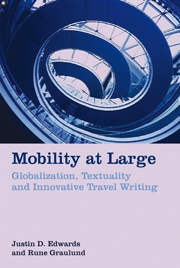Book contents
- Frontmatter
- Contents
- Acknowledgements
- Introduction: Travel Revisited
- 1 Travelling with the Ondaatje Bros.
- 2 Amitav Ghosh and Caryl Phillips: Global Travel, Then and Now
- 3 Unhomely Travels; or, the Haunts of Daphne Marlatt and W. G. Sebald
- 4 The World, My City: Home Grounds and Global Cities
- 5 Travel Histories – From Kuala Lumpur to Istanbul and Beyond
- Postscript: Still Mobile
- Bibliography
- Index
3 - Unhomely Travels; or, the Haunts of Daphne Marlatt and W. G. Sebald
- Frontmatter
- Contents
- Acknowledgements
- Introduction: Travel Revisited
- 1 Travelling with the Ondaatje Bros.
- 2 Amitav Ghosh and Caryl Phillips: Global Travel, Then and Now
- 3 Unhomely Travels; or, the Haunts of Daphne Marlatt and W. G. Sebald
- 4 The World, My City: Home Grounds and Global Cities
- 5 Travel Histories – From Kuala Lumpur to Istanbul and Beyond
- Postscript: Still Mobile
- Bibliography
- Index
Summary
I was sitting alone in my wagon-lit compartment when a more than usually violent jolt of the train swung back the door of the adjoining washing-cabinet, and an elderly gentleman in a dressing-gown and a travelling cap came in. I assumed that in leaving the washing-cabinet, which lay between the two compartments, he had taken the wrong direction and come into my compartment by mistake. Jumping up with the intention of putting him right, I at once realized to my dismay that the intruder was nothing but my own reflection in the looking-glass on the open door.
Sigmund Freud, ‘The Uncanny’ 248Freud is travelling alone on a train. The door to his compartment is thrown open and an aged man enters. It is a mistake. A stranger on the train, the man is an intruder. Freud leaps up to correct the old man and to send him where he belongs, elsewhere. But then he sees that the old man is not a stranger at all: he is looking at his own reflection in the mirror. Freud dislikes the experience and expresses his discomfort, citing it as an uncanny incident in which his ‘double’ draws him away from himself.
It is not surprising that Freud has this uncanny experience while travelling. Travel is always, in a sense, an encounter with displacement. And on this train, Freud finds himself displaced from the homely site of identificatory stability and certainty; he is not himself, he is strange, a stranger to himself.
- Type
- Chapter
- Information
- Mobility at LargeGlobalization, Textuality and Innovative Travel Writing, pp. 77 - 121Publisher: Liverpool University PressPrint publication year: 2012



